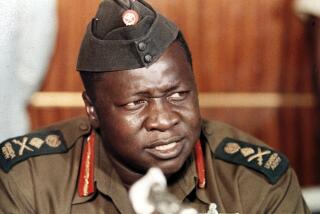Haile Selassie Laid to Rest in Ethiopia
ADDIS ABABA, Ethiopia — Bells tolled and thousands of Ethiopians wailed and applauded Sunday as Haile Selassie, their last emperor, was finally laid to rest 25 years after his mysterious death.
As leaders of the Ethiopian Orthodox Church stood by, elderly veterans of Ethiopia’s 1935-41 struggle against Italian occupation carried the coffin--draped in the nation’s red, green and gold flag--up the steps of Holy Trinity Cathedral. The emperor’s family, friends and associates embraced at their first public gathering since 1974, when he was overthrown by Marxist military officers.
The late emperor was important not only to Ethiopians. Hundreds of thousands of Jamaicans embraced him as their living god and head of the Rastafarian religious movement. Dozens, wearing red, gold and green caps covering their dreadlocks, attended the funeral.
A crypt had been waiting at the cathedral since Haile Selassie’s remains were discovered under a concrete slab on the grounds of his former palace in 1992, 17 years after he died under house arrest.
Officially, his death at age 83 was due to complications from a prostate condition. The Haile Selassie I Foundation, which had worked for eight years to give the emperor a suitable burial, claims he was assassinated.
During a trial that sought to bring members of the 1974-91 regime of Lt. Col. Mengistu Haile Mariam to justice for the killings of dissidents and pro-royalists, two of the emperor’s servants testified that he was killed on a night they were ordered out of his room.
Haile Selassie, who assumed the throne in 1930, was the last in a line of emperors who forged the modern Ethiopian state out of an ancient land of feuding chieftains.
To his supporters, his rule was a time of peace and stability during which modern education was introduced. Critics say he was too slow in reforming a feudal society.
Since the revolution that ousted him dissolved into terror, Ethiopians have suffered a series of wrenching events. A 1984-85 famine devastated the nation, and the 1991 ouster of Mengistu by another group of rebels sent the nation reeling once again.
While the funeral could be seen as the end of an era, the nation remains one of the world’s 10 poorest countries and has yet to formally end a two-year border war with neighboring Eritrea.
The government of Prime Minister Meles Zenawi, which grew out of the rebel movement that ousted Mengistu, made no formal statement about Haile Selassie until last week, when it called him “a tyrant and oppressor of the masses.”
Although the foundation issued an open invitation to the government to attend the funeral, no officials showed up, and state-run broadcast media--the only ones operating in this Horn of Africa nation--did not mention the event.
Randi Ronning Balsvik, a history professor at Norway’s Tromso University and an Ethiopian specialist, said Meles’ government had “played it all very safely” by allowing the funeral to take place, yet making clear its position on Haile Selassie’s legacy.
Many people too young to have lived through the days of the last emperor express nostalgia for them, “when life was orderly and prices didn’t rise all the time,” in the words of 21-year-old student Addesalem Tesfaye--but there is little sense here of a serious movement to reinstate the monarchy.
“We want to rehabilitate his name, but not only his name, that of Ethiopia as well, and our own history,” said Wolde-Semait Gebre-Wold, who was a senior official under the emperor and an organizer of the funeral. He said the foundation was seeking money to set up scholarships in honor of the emperor.
More to Read
Sign up for Essential California
The most important California stories and recommendations in your inbox every morning.
You may occasionally receive promotional content from the Los Angeles Times.










